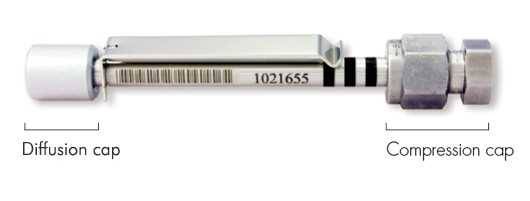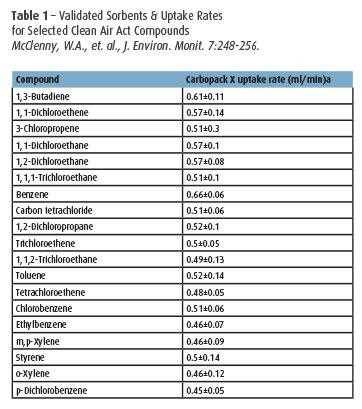EnviroMail 04 Canada
Fenceline Monitoring of Volatile Organic Compound Emissions by EPA Method 325
Fugitive volatile organic compound (VOC) releases from facilities in the petroleum and petrochemical sectors may pose health and environmental risks to Canadians. As part of the Government of Canada's Chemical Management Plan (CMP), new requirements will be imposed upon petroleum refineries, upgraders and certain petrochemical facilities to reduce the risk of exposure to humans and the environment.

In May 2013, the US EPA released a proposed rule as an update to the current “national emission standards for hazardous air pollutants for petroleum refineries” which required all refineries to monitor volatile benzene concentrations around the fenceline (perimeter) of their facilities. Benzene was selected as a representative compound to evaluate overall refinery emissions. Originally implemented as part of the annual Risk and Technology Review (RTR), the proposed rule was designed to establish a fenceline concentration of benzene that would trigger required corrective action in the event of an exceedance. This was a combined effort to evaluate both risk and technology as required by the Clean Air Act (CAA) after the application of maximum achievable control technology (MACT) standards.
The proposed rule was posted to the US Federal Register on June 30, 2014 with the final rule being signed and published on September 29, 2015. Implementation of this rule is intended to result in reductions of hazardous air pollutants that affect public health directly (cancer risk and chronic health effects), as well as indirectly by contributing to the formation of ground-level ozone (smog).
EPA Method 325 “Volatile Organic Compounds from Fugitive and Area Sources” was developed to enable refineries to comply with the updated US federal regulation 40 CFR 63. EPA Method 325 includes two sub-parts: EPA 325A: Sampler Deployment and VOC Sample Collection, and EPA 325B: Sampler Preparation and Analysis. These complementary methods outline the design, deployment, preparation, and analysis of a series of passive sampling sorbent tubes suspended around the refinery property line. After 2 weeks (14 days) of exposure, the passive sampling tubes are detached from the shelters, re-sealed and sent to a laboratory for thermal desorption (TD) gas chromatograph mass spectrometry (GCMS) analysis. Although benzene is the primary target compound, the sampling and analysis methodology can also be used to determine other VOCs, including 1,3-butadiene, toluene, ethylbenzene, xylenes and other hazardous air pollutants (HAPs).

Set-Up, Application and VOC Scope
Samples are collected using a 3.5” long x ¼” OD stainless steel tube packed with a carbon-based adsorbent. One end of the tube is outfitted with an open mesh diffusion cap and the other end is sealed with a brass cap. The tube is positioned with the diffusion cap in a downward orientation under a protective non-VOC emitting shelter. Shelters are placed at a height of 1.5 to 2 meters above the ground on a secure pole or other suitable structure. At least one co-located duplicate sample is collected for every 10 field samples. A minimum of two unopened field blanks are collected in different shelters per sampling period to ensure sample integrity associated with shipment, collection and storage.
Monitoring points are determined using an equal radial or linear approach, eg. Radial: Less than 750 acres, samplers every 30 degrees based on a central emission source point (12 samples); Linear: Boundary less than 24,000 feet, a minimum of 12 sampling locations evenly spaced ±10%. Based on 26 two-week sampling events, a yearly rolling average is created which is then compared to a specified action level.
The preferred sorbent is Carbopack X, a medium/strong sorbent (n-C3/C4 to n-C8). It is optimal for passive adsorption of the target analytes listed including benzene and 1,3-butadiene; and is hydrophobic, minimizing moisture effects. The use of a diffusion cap and slow analyte diffusion rate (uptake rate) mitigate any extreme changes in wind vector.
New tubes are thermally conditioned, the base flow measured and then checked for desorption efficiency (DE). The tubes can be cleaned to low background levels enabling target analyte detection at ppb/ppt levels. Uptake rates are based on Fick’s Law of Diffusion (a compound will migrate to the surface of a sorbent at a rate dependent on: distance and area between sorbent and source, time of exposure, diffusion coefficient of the compound through air and ambient concentration). Without an uptake rate no comparison can be made between the amount of analyte measured on the tube and concentration at the sampling point.

Regulation
A recent publication (May 2017) in the Canada Gazette, indicates that a fenceline monitoring program for petroleum and petrochemical sectors will come into effect on January 1, 2018 and be applied across Canada effective July 1, 2018.
http://www.gazette.gc.ca/rp-pr/p1/2017/2017-05-27/html/reg2-eng.php.
This program will require 18 petroleum refineries, 6 upgraders and 2 petrochemical facilities to sample and analyze the concentrations of certain VOC’s (benzene, 1,3-butadiene, as well as the total concentration of all retainable VOCs) around their respective facilities’ perimeters as per U.S EPA Method 325A and 325B.
While regulations come into effect in the future, ALS has the capability and CALA accreditation for these methods to enable the industry to monitor their sites in advance of regulatory enforcement thereby allowing industry to perform any corrective action earlier if desired.
ALS will provide a standard suite of analytes (as per Table 1) unless requested otherwise and to request this service industry should as for the ALS ABC package and ALS can not cannot supply TD tubes as part of the cost.
For more information, contact the ALS environmental laboratory in Waterloo, Ontario.
















































